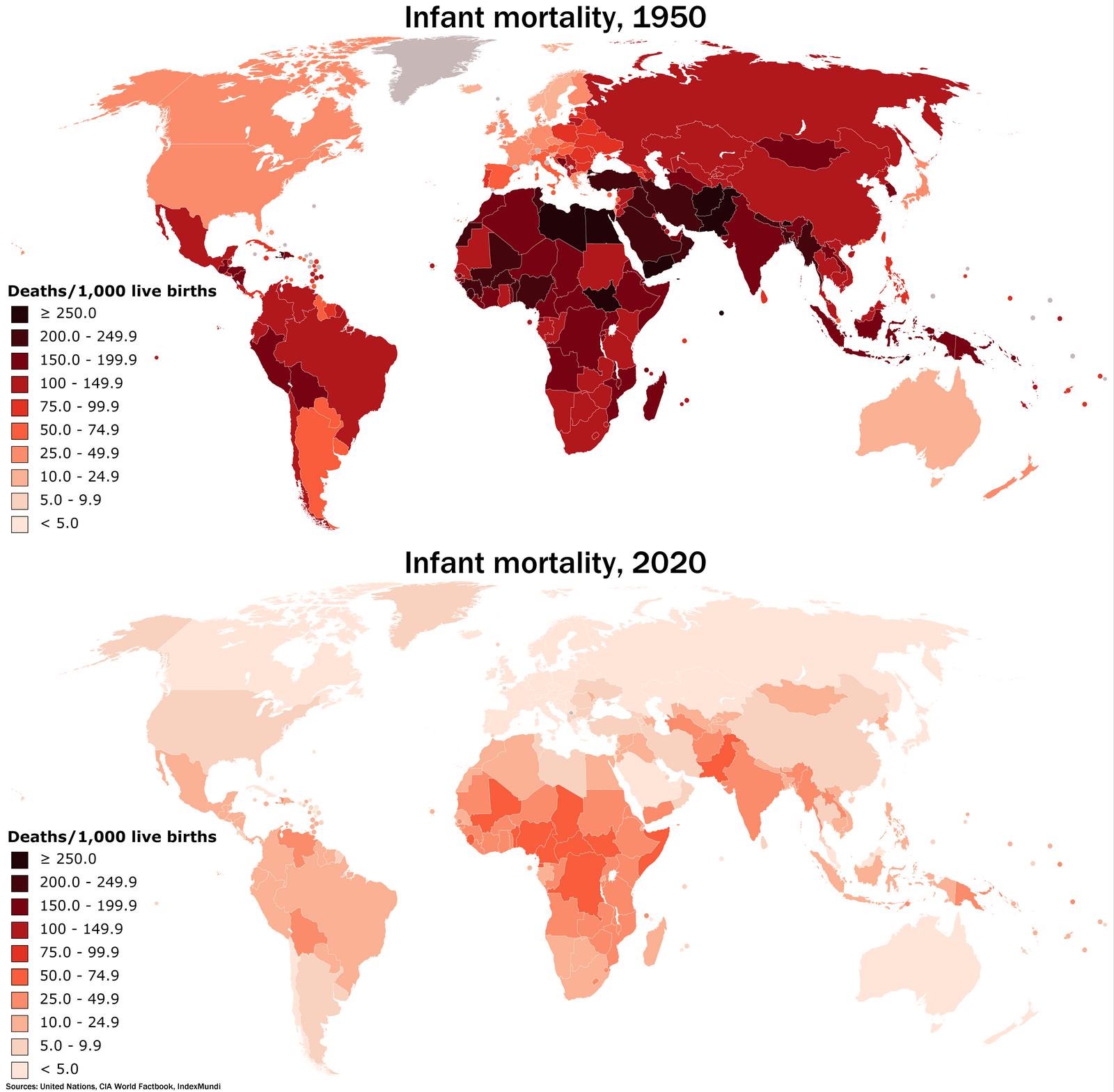
Infant mortality rates remain a critical public health issue in the United States, particularly highlighting stark disparities between Black and white populations. Despite the overall progress in life expectancy for both racial groups, the statistics reveal a troubling trend: Black infants are now dying at double the rate of their white counterparts. A recent extensive study spanning 70 years has unveiled that while general mortality rates have improved, the racial health gap persists, particularly among the youngest and most vulnerable. These alarming health disparities emphasize the urgent need for targeted interventions to ensure equitable healthcare access and outcomes for all infants, regardless of race. Understanding the underlying causes of these inequities is essential as we strive to close the gap in infant mortality rates and improve health disparities in our society.
In the realm of public health, the discussion surrounding the rates of infant loss continues to ignite concern and debate, especially when viewed through the lens of racial inequities. The contrast in mortality figures between infants of different racial backgrounds highlights an ongoing crisis that many refer to as a widening chasm in health outcomes. Recent findings indicate not only a stagnation in improvement for some groups but an unsettling rise in the risks faced by Black infants compared to their white peers. This situation starkly illustrates the concept of health disadvantages, where systemic factors contribute to uneven life chances and ultimately affect life expectancy statistics. Addressing these disparities is crucial, as it lays the groundwork for a healthier future for all newborns.
The Alarming Disparity of Infant Mortality Rates
Recent studies reveal a stark contrast in infant mortality rates between Black and white Americans, highlighting a critical public health issue that continues to persist. The findings indicate that Black infants are, alarmingly, dying at double the rate compared to their white counterparts. This troubling statistic is a wake-up call about the health disparities that exist not just in overall mortality, but specifically within the infant population, which is the most vulnerable segment of society.
The increase in the racial health gap between Black and white infants over the years is especially concerning. In the 1950s, the mortality rate for Black infants was already high at 92% compared to white infants, but today that rate has surged to 115%. This evolution in infant mortality rates points to systemic issues in healthcare access, quality of care, and socio-economic factors that disproportionately affect Black families. Without addressing these disparities, progress made in other areas of healthcare will remain incomplete.
Understanding Health Disparities in Infant Mortality
The persistence of health disparities can often be attributed to multiple factors including economic instability, lack of access to quality healthcare, and the social determinants of health that disproportionately affect Black communities. Issues such as inadequate prenatal care, nutrition, and education about maternal health can lead to adverse health outcomes for both mothers and their infants. Understanding these underlying causes is crucial because they weave into the larger tapestry of racial health inequities.
Furthermore, institutional racism and implicit biases in healthcare delivery cannot be overlooked. Research indicates that Black mothers often receive different treatment compared to white mothers, which can exacerbate existing health disparities. These factors contribute to the widening gap in infant mortality rates, as systemic barriers prevent equitable access to needed health services during pregnancy and after childbirth. Consequently, addressing infant mortality rates requires a multifaceted approach that targets these systemic issues.
Racial Health Gap: A 70-Year Perspective
Looking back over a 70-year span provides invaluable insight into the evolution of the racial health gap in the United States. While life expectancy has significantly improved for both Black and white Americans, the benefits of this progress have not been evenly distributed. The research shows that the mortality rate between these two groups has narrowed in adult populations, yet the same cannot be said for infants. This shift emphasizes the urgency for focused interventions that address the specific needs of Black infants.
The widening disparity in infant mortality illuminates the inadequacies in our healthcare system when it comes to addressing the unique challenges faced by Black families. It underscores the need for targeted public health policies that prioritize maternal and infant health in Black communities, ensuring equitable access to resources that can prevent infant deaths. A comprehensive understanding of the historical context of these disparities can inform future efforts to bridge the gap and promote better health outcomes.
Life Expectancy Statistics: The Broader Picture
While life expectancy figures have shown positive trends, the disparities in child and infant mortality rates present a troubling contradiction. According to the latest statistics, Black Americans have experienced a 20% increase in life expectancy since the 1950s, compared to a 13% rise among white Americans. This might suggest an overall improvement; however, it masks the critical reality that when it comes to our youngest population, the situation is dire.
This disparity illustrates a gap that transcends age, emphasizing the importance of looking at health metrics through a lens that considers various demographic factors. The improved life expectancy statistics for adults should not detract from the urgent need to address the systemic issues leading to high infant mortality rates, particularly in Black infants. Moving forward, it is essential to focus on these metrics in tandem to ensure a healthier future for all demographic groups.
The Role of Public Policy in Closing the Racial Health Gap
Public policy plays a pivotal role in addressing the disparities found within maternal and infant health outcomes. This research calls for heightened awareness and action from policymakers to ensure that all individuals, especially Black mothers and their infants, have access to the necessary healthcare resources. Effective public health interventions must be implemented to provide equitable healthcare access, quality prenatal care, and educational resources that empower families.
Moreover, there is a pressing need for policies that tackle the root causes of healthcare disparity, such as poverty, education inequality, and systemic racism. By strategically investing in healthcare for Black communities and enhancing support systems, it is possible to begin closing the gap that has persisted for decades. Ultimately, public health officials must prioritize these measures to ensure that all infants have an equal chance at a healthy start in life, regardless of race.
Addressing the Causes of Excess Death in Black Infants
Identifying the specific causes behind the excess mortality among Black infants is essential for implementing effective interventions. Medical conditions during pregnancy have been revealed as leading causes of infant deaths in recent decades, which highlights the need for improved prenatal care and maternal health services. Addressing these health disparities demands a comprehensive understanding of how socio-economic status, education, and access to healthcare influence maternal and infant health outcomes.
Furthermore, public health stakeholders must advocate for research that delves into both medical and non-medical contributors to higher infant mortality rates among Black populations. By comprehensively investigating these factors, healthcare providers and policymakers can develop targeted health programs that reflect the unique challenges faced by these communities. Collaboration with local organizations and community leaders will be vital in tailoring solutions that will effectively mitigate these disparities.
The Impact of Healthcare Quality on Infant Mortality Rates
The quality of healthcare received by mothers is a crucial determinant of infant mortality rates. Studies have shown that Black mothers often face disparities in the quality of care compared to their white counterparts, which can lead to worse health outcomes for their babies. Improving healthcare quality is, therefore, a fundamental step in addressing the racial gap in infant mortality.
Ensuring that healthcare providers are culturally competent and aware of the challenges faced by Black families can significantly enhance the quality of care. Training programs and policy initiatives aimed at improving maternal healthcare will ultimately create a more equitable healthcare system. By focusing on quality and equity in healthcare, we can take significant strides toward reducing the infant mortality rates that disproportionately affect Black infants.
Community Engagement and Its Role in Reducing Infant Mortality
Engaging communities directly in health initiatives is vital for addressing racial disparities in infant mortality. Community-based programs that educate families about healthcare access, maternal health, and the importance of prenatal care can empower individuals to seek and utilize available resources. By fostering a relationship between healthcare providers and the communities they serve, more effective interventions can be developed.
Additionally, incorporating local voices in the decision-making process can ensure that health initiatives are culturally relevant and adequately address the unique needs of Black families. This grassroots approach not only promotes awareness but also encourages community members to participate actively in their healthcare decision-making, ultimately helping to lower infant mortality rates and bridge the racial health gap.
The Path Forward: Bridging the Racial Health Gap
In conclusion, the research indicating increasing disparities in infant mortality rates between Black and white Americans underscores the need for a renewed commitment to address these issues at both policy and community levels. To move forward, it will be crucial to bring attention to the healthcare inequalities that have persisted for decades and to dedicate resources toward eliminating them.
Furthermore, a multilateral approach that includes policymakers, healthcare providers, and community organizations is essential in developing targeted solutions that will effectively bridge the racial health gap. The goal should be to create a healthcare system that not only improves life expectancy but also ensures that all infants have equal opportunities for a healthy start in life, regardless of race.
Frequently Asked Questions
What are the current trends in infant mortality rates between Black and white American infants?
Infant mortality rates reveal a concerning trend; Black infants are dying at rates nearly double that of white infants. Recent studies indicate that while overall mortality rates have improved for both racial groups, the gap in infant mortality has widened, with Black infants facing a 115% higher mortality rate compared to white infants.
How do health disparities affect infant mortality rates among Black and white infants?
Health disparities significantly impact infant mortality rates, particularly for Black infants. These disparities stem from multifaceted issues such as unequal access to healthcare, differences in the quality of care received, and social determinants of health. Consequently, Black infants experience higher mortality rates compared to their white counterparts.
What are the leading causes of excess mortality among Black infants?
The leading causes of excess mortality among Black infants primarily stem from medical conditions during pregnancy. Factors contributing to these adverse outcomes include healthcare inequality, access to prenatal care, and systemic issues affecting the quality of care provided to pregnant Black women.
Why have infant mortality rates among Black infants worsened over the past 70 years?
Despite improvements in overall life expectancy and healthcare access, infant mortality rates among Black infants have deteriorated over the last 70 years. This alarming trend highlights the persistent racial health gap and indicates that systemic issues in healthcare have not been adequately addressed.
What should policymakers prioritize to reduce racial disparities in infant mortality rates?
Policymakers should prioritize closing the racial health gap by ensuring equitable access to quality healthcare for all expectant mothers, especially in underserved communities. This includes addressing social determinants of health, improving prenatal care, and investing in public health initiatives aimed at reducing infant mortality rates among Black infants.
How do life expectancy statistics correlate with infant mortality rates between Black and white Americans?
While life expectancy statistics have shown improvements for both Black and white Americans, the correlation with infant mortality rates is troubling. Although adults are living longer, this extends to higher rates of infant deaths among Black infants, illustrating an ongoing racial disparity in health outcomes despite overall advancements in healthcare.
What role does systemic inequality play in the differences between Black and white infant mortality rates?
Systemic inequality plays a critical role in the differences between Black and white infant mortality rates. Factors such as socio-economic status, healthcare access, and discrimination within healthcare systems contribute to the higher rates of mortality among Black infants, demonstrating a need for comprehensive reforms in public health policies.
What can be done to address the widening gap in infant mortality rates?
To address the widening gap in infant mortality rates, targeted interventions should focus on improving healthcare access for Black mothers, enhancing the quality of prenatal care, and implementing policies that address social determinants of health. Additionally, increased funding for research into the root causes of these disparities is essential.
| Key Point | Details |
|---|---|
| Mortality Rates Overview | Life expectancy for both Black and white Americans has improved, but disparities persist. |
| Infant Mortality Gap | Black infants die at twice the rate of white infants; gap has widened from 92% higher in the 1950s to 115% today. |
| Reasons for Disparity | Excess mortality among Black infants primarily stems from medical conditions during pregnancy and healthcare inequalities. |
| Longitudinal Study | This study spans 70 years, providing a comprehensive view of the changing landscape of mortality rates. |
| Call to Action | The findings indicate a need for public policy and health authorities to address these gaps actively. |
Summary
Infant mortality rates highlight a critical issue in public health, demonstrating that even as overall life expectancy increases, significant disparities persist between racial groups. While Black infants now face mortality rates that are double that of white infants, highlighting a growing gap, more must be done to address these inequalities. The alarming statistics call for urgent intervention from healthcare policymakers and researchers to identify and remedy the root causes of these disparities, ensuring that all infants have equal chances at survival and thriving.




